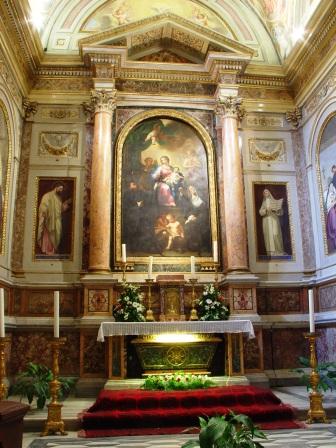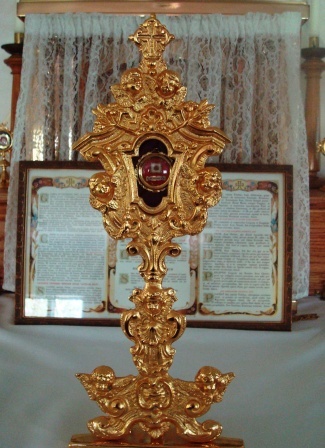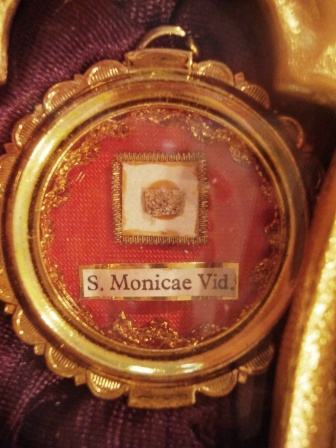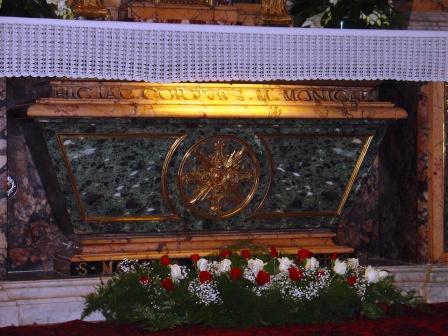
To the right is a shot of the chapel on the day some years ago when the bones of her son, St. Augustine, were brought from their resting place in Pavia (near Milan) to Rome.
For the first time since 387, son and mother were reunited.
How did St. Monica’s tomb wind up here?
Here is an excerpt from an article I wrote for Inside the Vatican (December 2004) on the above mentioned event. I used the alternate (and more accurate Punic) spelling of the saint’s name – “Monnica” (emphasis not in the original):
Most visitors to the Eternal City find it puzzling and wondrous that Monnica’s remains would be in Rome and even more so that Augustine’s should be in northern Italy, or that we have them at all. How did this come to pass? Monnica died at age 56 of a malarial fever at Ostia, Rome’s port city, not far from where modern Rome’s port, DaVinci airport, is situated. After Augustine’s baptism in 386 by Milan’s bishop St. Ambrose (+ AD 397), Monnica and Augustine together with his brother Navigius, Adeodatus the future bishop’s son by his concubine of many years whom Monnica had forced Augustine to put aside, and friends Nebridius, Alypius and the former Imperial secret service agent (agens in rebus) Evodius were all waiting at Ostia to return home to Africa by ship. They were stuck there for some time because the port was blockaded during a period of civil strife. As she lay dying near Rome, Monnica told Augustine (conf. 9): “Lay this body anywhere, let not the care for it trouble you at all. This only I ask, that you will remember me at the Lord’s altar, wherever you be.” She was buried there in Ostia. In the 6th century she was moved to a little church named for St. Aurea, an early martyr of the city, and there she remained until 1430 when her remains were translated by Pope Martin V to the Roman Basilica of St. Augustine built in 1420 by the famous Guillaume Card. D’Estouteville of Rouen, then Camerlengo under Pope Sixtus IV. As fate or God’s directing have would have it, in December 1945, some children were digging a hole in the courtyard of the little church of St. Aurea next to the ruins of ancient Ostia. They wanted to put up a basketball hoop, probably having been taught the exciting new game – so different from soccer – by American GIs. While digging they discovered the broken marble epitaph which had marked Monnica’s ancient grave. Scholars were able to authenticate the inscription, the text of which had been preserved in a medieval manuscript. The epitaph had been composed during Augustine’s lifetime by no less then a former Consul of AD 408 and resident at Ostia, Anicius Auchenius Bassus, perhaps Augustine’s host during their sojourn. It is possible that Anicius Bassus placed the epitaph there after 410 which saw the ravages of Alaric the Visigoth and the sacking of Rome a
nd its environs. One can almost feel behind these traces of ancient evidence Augustine’s plea to his old friend sent by letter from the port of Hippo Regius over the waves to Ostia. Hearing of the devastation to the area, far more shocking to the ancients than the events of 11 September were for us, did Augustine, now a renowned bishop, ask his old friend to tend the grave of the mother whom he had so loved and who in her time had wept for her son’s sins and rejoiced in his conversion?
Looking for a great book on Augustine? Try this!
Meanwhile, in the chapel here there is a relic of St. Monica. May she pray for us, for widows and for parents of children who have drifted from the Church.






































Fr. Z,
Was the epitaph those words from the Confessions, or something
else?
Excellent peice Father, I always say that St Monica is the ‘human’ version of the Blessed Virgin, I say this because if you think about it The Blessed Virgin Mary had it fairly easy as one does if your completely preserved form Original Sin and its effects, wheras St Monica had a bit of a fondness for Wine in her earlier years and therefore needed a lifelong conversion as much as the rest of us.
Two Quick Questions if you have the time
a) is the above line of thinking ok or does it sound iffy or disrespectful to either the Blessed Virgin or St Monica?
b) how does one go about collecting relics? Its just that people I know whose families have been Catholic for hundreds of years quite often have Family shrines complete with relics of Saints. I know that either having one/not having one doesn’t make me a better/worse Catholic but as a Convert I’m finding out that being a philosphical/theological smartypants, knowing Aquinas’s five ways, and knowning the facts about Sacred Scripture and the faith inside out contributes very little to one’s Catholic Identity which comes from the the little things i.e. praying in Latin, The Rosary, reading the live’s of saints, going on pilgramige ect ect and I get the feeling that these people who do have Family Shrines derive a certain part of their identity and comfort from having the relics of the cannonized/Blessed in their homes even if their understanding of the faith isn’t as great as some of us who wern’t born into it.
FrZ.,
That photo of St. Monica’s is familiar. Didn’t you celebrate a Mass at that altar? I believe you’ve posted about it before.
“May she pray for us, for widows and for parents of children who have drifted from the Church.”
…and for children whose parents have drifted from the Faith.
I think you made that St. Augustine book “Temporariily Out of Stock” with your recommendation :)
Konichiwa: Perhaps. But do aim at the used copies. Good book.
bury me anywhere, but remember me at the Alter
I think I may have passed this church during three of my trips to Rome!
In 1977, 1979 and 1981 I stayed at the Hotel Michelangelo which is near the Vatican. Had to cross a rather busy street to get to St. Peter’s, and there was a church on the corner of that street. It had either ‘St. Augustine’ or ‘St. Monica’ in inscribed in Latin on the front of it, ‘way up near the roof.
Thanks, Father, for the tip on a good book about St. Augustine – I ordered it yesterday, not even remembering it’s his Feastday today! Realizing that at Mass this morning was a nice surprise.